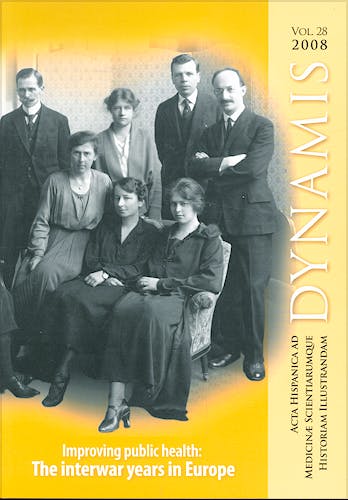

No hay productos en el carrito



Dynamis. Acta Hispanica Ad Medicinae scientiarumque.. Vol 28 (2008)
AAVV
1ª Edición Noviembre 2008
Otros
Tapa blanda
475 pags
1200 gr
16 x 22 x 2 cm
ISBN 9788433846495
Editorial UNIVERSIDAD DE GRANADA
11.—Background. 2.—The League of Nations Health Organisation becomes involved. 2.1.—The psychological effects of unemployment. 2.2.—Colonization. 2.3.—Statistical methods. 2.4.—Ways to safeguard health in times of depression. 2.5.—Nutrition. 3.—Conclusions.
* Vassiliki Theodorou and Despina Karakatsani. Health policy in interwar Greece: the intervention by the League of Nations Health Organisation
1.—Concerns about public health after World War I. 2.—Refugee settlement and the appeal to the international community. 3.—The appeal to the League of Nations. 4.—The L.N.H.O. plan. 4.1.—The first reactions. 5.—The involvement of the Rockefeller Foundation and the campaign against malaria. 6.—The accomplishments of the involvement of international health organisations. 7.—Concluding remarks: what caused the plan to fail.
* Alfredo Menéndez-Navarro. The politics of silicosis in interwar Spain:
Republican and Francoist approaches to occupational health
1.—Introduction. 2.—Social reform and the emergence of silicosis
in interwar Spain. 3.—Tackling silicosis during the Republic: the Law
of Occupational Diseases and the Foundation for the Fight against Silicosis.
4.—Autarky, social insurance and political repression: approaching silicosis
during the First Francoism. 5.—The Silicosis Scheme in early Francoist
Spain (1941-1946). 6.—Conclusions.
* Josep Lluís Barona y Enrique Perdiguero. Health and the war. Changing schemes and health conditions during the Spanish civil war
1.—Introduction. 2.—The Popular Front and the politics of health: changes and controversies. 3.—Health organization after the outbreak of the Civil War. 4.—Impact of the war on population’s health. 5.—Evacuation of the refugees. 6.— Experts in action: clinical studies on undernourishment. 7.—The situation at the end of the Civil War. 8.—Conclusion.
* Nadav Davidovitch and Rakefet Zalashik. «Air, sun, water»: Ideology and activities of OZE (Society for the preservation of the health of the Jewish population) during the interwar period
1.—Introduction. 2.—Jews and health in Eastern Europe. 3.—The establishment of OZE and its activities. 4.—OZE crisis and reconstruction. 5.—Typhus. 6.—Favus. 7.—Discussion.
* Ida Blom. «How to have healthy children». Responses to the falling birth rate in Norway, c. 1900-1940
1.—Legislation supporting mothers. 2.—Clinics for mothers and infants. 3.—Low attendance, reduced breast feeding, reduced infant mortality. 4.—Hygienic mothers’ clinics – (Mødrehygienekontorer). 5.—Discussing fertility and infant health. 6.—Sterilisation – part of welfare policies? 7.—Conclusion.
* Martin Gorsky. Public health in interwar Britain: did it fail?
1.—Public health in Interwar local government. 2.—The historiography of interwar public health. 3.—Public health and population health. 4.—Did public health fail? A case study from the South-West. 5.—Conclusion.
© 2025 Axón Librería S.L.
2.149.0